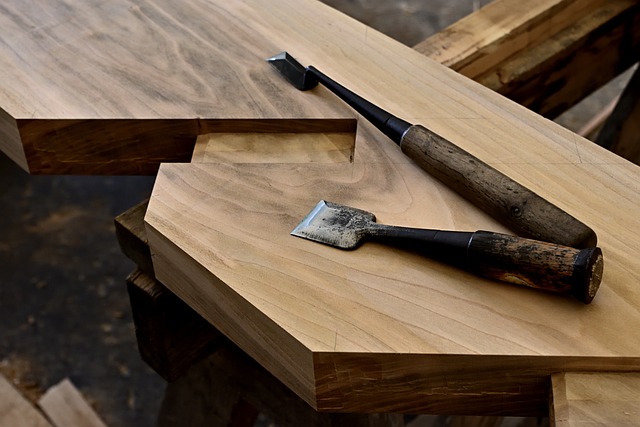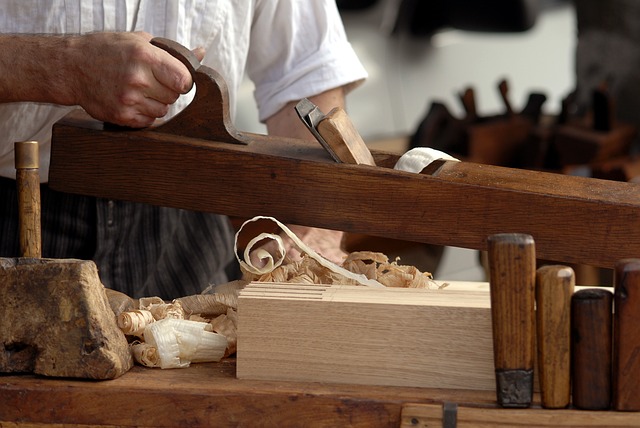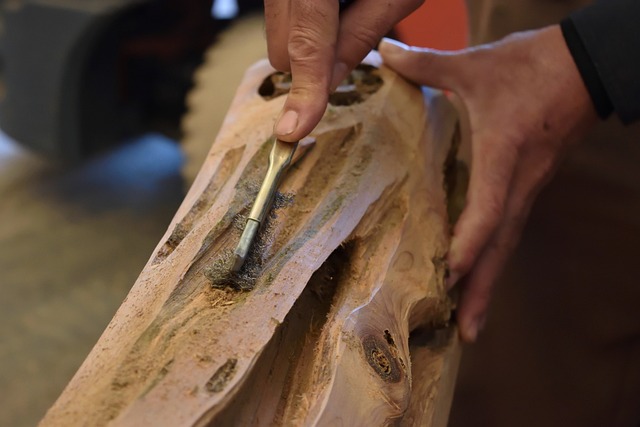TL;DR: Carpenters are vital in constructing and repairing wooden structures, ensuring they are both functional and aesthetically pleasing. Their expertise includes careful lumber selection for stability and appearance, with an understanding of wood's characteristics and the forces it must endure. In construction, carpenters erect frameworks with precision, while repairs are guided by original blueprints to maintain structural design and aesthetic vision. Carpenters may need to replace or reinforce wooden components, matching the grain and dimensions of the originals for seamless integration. The choice of softwood or hardwood is critical based on the task's needs, with softwoods like pine favored for framing due to their workability and cost-effectiveness, while hardwoods are chosen for their durability in high-stress areas.
Carpenters also excel in sheathing walls with robust materials like plywood or OSB, ensuring they are weather-resistant and free from gaps or warping. They use advanced tools and techniques to optimize material usage while maintaining structural integrity, adopting modern framing methods that enhance energy efficiency. The assembly of wall panels requires precision, with carpenters interlocking timber planks flawlessly and using high-quality adhesives and fasteners to ensure long-term stability in various climates. Detecting and correcting wood imperfections before assembly is crucial for preventing future issues. Overall, carpenters are dedicated professionals who construct frameworks that withstand the test of time, ensuring the reliability and comfort of living spaces.
Embarking on constructing or repairing wooden structures requires a blend of traditional craftsmanship and modern techniques. This comprehensive guide delves into the carpenter’s essential practices, from selecting quality timber to executing precise finishing touches. We explore the intricacies of framing, sheathing, and roofing, ensuring durability and weather resistance. Carpenters’ best practices for siding, window and door installation, and interior surface preparation are highlighted to achieve both functionality and beauty. Additionally, we address the importance of regular maintenance, repair techniques for common issues, and innovative sustainable approaches in wooden structure upkeep. This article serves as a valuable resource for carpenters and enthusiasts alike, offering insights into the latest technologies enhancing the craft and preserving historical restorations with reverence for tradition.
- Understanding Wooden Structure Framework: The Carpenter's Blueprint
- Selecting the Right Timber: A Carpenter's Guide to Quality Materials
- Mastering the Art of Joist and Rafter Installation: Techniques for a Strong Foundation
- Sheathing Essentials: Carpenter's Best Practices for Durability and Weather Resistance
- The Carpenter's Craft: Perfecting Wall Panel Assembly for Stability and Integrity
Understanding Wooden Structure Framework: The Carpenter's Blueprint

When constructing or repairing wooden structures, from residential homes to commercial buildings, a carpenter’s blueprint serves as the foundational guide. This meticulously drafted plan delineates every component of the framework, ensuring that each piece of wood is precisely placed to create a stable and functional structure. The carpenter interprets this blueprint, translating it into tangible form with an intimate understanding of wood’s properties and the forces it must withstand. This process begins with the selection of lumber, where the carpenter assesses the grain, moisture content, and straightness of each board to guarantee structural integrity. The framework, or skeleton of the structure, is then erected with careful attention to alignment and fit, as these initial steps are critical for subsequent finishing work.
Repairing wooden structures often requires a different set of skills from those used in new construction. The carpenter must assess the damage, understanding whether it’s a matter of reinforcing joints or replacing entire sections. In either case, the repair work is informed by the original blueprint, allowing the carpenter to maintain the structural design and aesthetic intentional in the initial planning. This process might involve cutting new members that match the original in size, shape, and grain pattern, ensuring a seamless blend of old and new. Throughout both construction and repair, the carpenter’s expertise lies in their ability to work with wood, respecting its natural character while adhering to the precise specifications outlined in the blueprint. This harmonious approach between craftsmanship and precision is what underpins the longevity and functionality of wooden structures.
Selecting the Right Timber: A Carpenter's Guide to Quality Materials

When embarking on a project that involves constructing or repairing wooden structures, from framing to finishing, the foundation of any high-quality work is the selection of superior timber. A skilled carpenter understands that the integrity and longevity of a structure are largely dependent on the quality of wood used. The choice between softwood and hardwood, for instance, should be informed by the specific demands of the project. Softwoods like pine and spruce are favored for their workability and affordability, making them suitable for framing, whereas hardwoods such as oak and mahogany offer greater durability and resistance to wear and tear, making them ideal for more exposed areas or high-load bearing components.
Furthermore, the carpenter must consider the timber’s grain pattern, moisture content, and the presence of natural defects. The wood should be free from knots and check, which can compromise the structure’s strength and appearance. It is also imperative to assess the straightness of the boards; crooked timber will not only look unsightly but can lead to structural weaknesses over time. By selecting timber that meets these criteria, a carpenter ensures that the wooden structures they construct or repair are not only visually appealing but also robust and enduring. The right materials set the stage for a job well done, providing the foundation for precision craftsmanship and resulting in a structure that stands the test of time.
Mastering the Art of Joist and Rafter Installation: Techniques for a Strong Foundation

A seasoned carpenter understands that the installation of joists and rafters is a pivotal step in constructing or repairing wooden structures, serving as the bedrock for the roof’s integrity. This process demands precision and expertise to ensure the framework can withstand environmental stresses and support the weight of the roofing materials and any additional loads. To begin, the carpenter must accurately measure and mark the layout of the joists on the wall plate and sill plate, ensuring a level foundation upon which the rafters will be set. Proper alignment of the joists is crucial for distributing the weight evenly and providing a stable surface for the rafters to rest upon.
When installing rafters, the carpenter employs various techniques tailored to the specific project requirements. These may include cutting angles to achieve the desired slope for drainage or aligning with existing structures. The carpenter must also consider the type of roof system, whether it be a simple gable, hip, or more complex designs, as this will influence the method of rafter installation. Advanced techniques such as the use of laser levels, plumb bobs, and squares facilitate precision in creating the necessary pitch, ensuring that each rafter is securely fastened to both the joists below and the plate above with appropriate hardware like galvanized nails or screws. This meticulous approach to joist and rafter installation by a skilled carpenter not only forms a strong foundation but also contributes to the longevity and performance of the wooden structure, making it imperative for those in the trade to master these techniques through practice and adherence to building codes and industry standards.
Sheathing Essentials: Carpenter's Best Practices for Durability and Weather Resistance

When it comes to sheathing wooden structures, a carpenter’s precision and understanding of materials are paramount for durability and weather resistance. Sheathing serves as a critical layer that provides structural integrity, stability, and protection against environmental elements. To ensure the best outcomes, carpenters must adhere to several best practices during this phase. Firstly, selecting the appropriate sheathing material is essential; options like plywood or oriented strand board (OSB) are commonly used for their strength and performance. These materials should be acclimated to the job site conditions before installation to minimize the risk of warping or swelling later on.
During installation, carpenters must align the sheathing boards correctly, ensuring they overlap at the joints without gaps that could compromise the structure’s integrity. Fastening these boards securely with the correct type and number of fasteners is also crucial. Galvanized or stainless steel nails or screws are recommended to resist corrosion, especially in areas with high moisture or salty environments. Proper spacing between fasteners prevents wood movement from causing damage. Additionally, sealing all edges and joints with a weather-resistant sealant protects against water intrusion, which can lead to decay and mold growth. By following these best practices, carpenters not only enhance the longevity of the structure but also ensure it withstands various climatic conditions effectively.
The Carpenter's Craft: Perfecting Wall Panel Assembly for Stability and Integrity

When constructing or repairing wooden structures, the artistry and technical prowess of a carpenter come to the forefront, especially during wall panel assembly. The stability and integrity of walls are paramount for both structural soundness and the longevity of the building. A carpenter must meticulously align each plank, ensuring that every joint is secure and every fastening is tight. This process begins with selecting the appropriate timber, considering its grain, density, and resistance to environmental factors. The carpenter’s tools and techniques are applied with precision to interlock the panels seamlessly. Advanced framing methods, which prioritize efficient use of materials while maintaining structural strength, are often employed. These methods may include the use of longer spans between studs where walls span unobstructed spaces, thereby reducing material waste and improving energy efficiency.
Moreover, the integration of modern adhesives and fasteners that withstand various climatic conditions is crucial in maintaining the wall’s structural integrity over time. Carpenters must also be adept at identifying any warping or twisting in the wood before assembly to prevent future complications. Once the panels are in place, they are carefully checked for plumb and level, and any necessary adjustments are made. The carpenter’s craftsmanship is not only about joining pieces of wood; it’s about creating a framework that stands the test of time, both in its physical form and as a testament to the skill and dedication invested in the work. This meticulous approach to wall panel assembly by skilled carpenters ensures that the structure will perform reliably, offering occupants a safe and comfortable environment.
In concluding our exploration of wooden structure construction and repair, it is evident that a carpenter’s expertise lies in the careful selection of timber, the precision of framing installation, and the attention to detail required throughout each phase, from sheathing to wall panel assembly. A master carpenter understands that a strong foundation, durable materials, and meticulous craftsmanship are paramount to achieving a stable and weather-resistant wooden structure. By adhering to these principles, carpenters can ensure the longevity and integrity of the buildings they construct, providing homeowners with safe, efficient, and aesthetically pleasing spaces for years to come.
